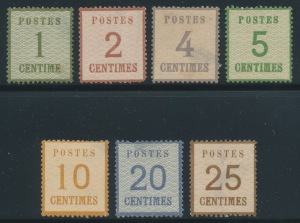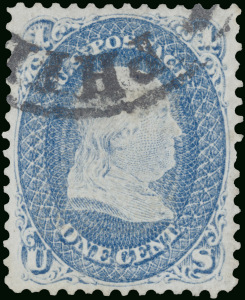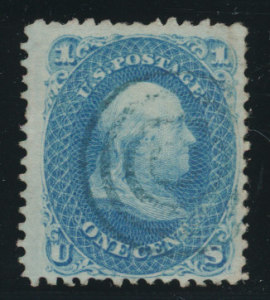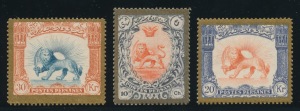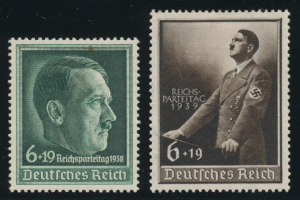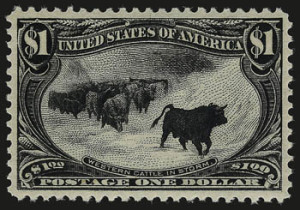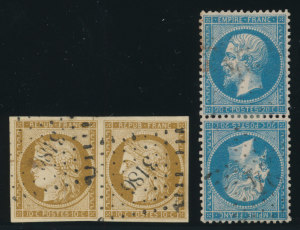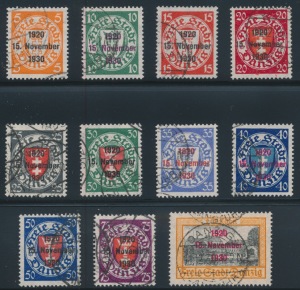Monthly Archives: June 2017
- Posted June 30, 2017Read more »At the turn of the twentieth Century, the Post Office of the United States was under constant criticism from philatelists because of our stamp issuing policy. The Post Office had decided to commemorate the 1893 Columbian Exposition with a long commemorative set, and the set they produced (Scott #230-245) had a face value of over $16 (the average weekly wage that year was less than $10). The Columbian set was just part of the high cost of collecting in the 1890s. In the mid-1890s, the Post Office had issued a long definitive set with a postage value of over $10. And a few years later, the set was reissued on watermarked paper. To philatelists, watermarked stamps represent completely different varieties than unwatermarked, and so collectors had to pony up another $10. The 1898 Trans Mississippis added another $3.50. To keep up with the issues of the 1890s, collectors had to spend over $40. In 2010 terms, this represented the equivalent wages of over a month or
- Posted June 29, 2017Read more »A collector once challenged me in an email. Find the first stamp object on your desk, and write an article on it, the only rule being that the item have no obvious philatelic value. Straight away my eyes alighted on the item found above.The Dutch stamp on this cover is one of the most common stamps of the world, similar to the 1¢ Franklin stamps that the United States issued from 1900-1970, mostly to make up postage differences on envelopes with other stamps. This cover was sent in 1955 from Graveshaven to Trenton New Jersey. It bears the corner card of the International Patent Research Office (IRPO) and is addressed to the Thermoid Corporation. Thermoid is a maker of industrial belts and machine equipment used in the automotive and
- Posted June 27, 2017Read more »The nineteenth century was a wonderful time for progress. Rapid scientific advances and technological innovations created a mindset that change was possible, even preferable, and that change could be a positive force. The current attitude is "if it ain't broke, don't fix it." In the nineteenth century, people looked for better ways to do things. People like Thomas Edison didn't happen upon new ideas; they actively looked for things to invent. Rowland Hill wasn't just an innovator; he called himself a "Reformer." He turned his attention to Great Britain's postal service in 1838, and philately is the result.Postal Service worldwide was always slow, expensive, and a bureaucratic mess. Great Britain was no worse than many countries, but costly and cumbersome
- Posted June 26, 2017Read more »Great thematic stamp collections help the viewer understand history in new ways. Recently, a collection came our way that underscores this. The collector, a historian, had a thesis that modern history is viewed through too narrow a lens. He took a long view of European history. The Hundred Years' War, for instance, was never called that by the five generations of men and women who fought and suffered through them. They saw the conflict, fought between 1337 and 1453, as a series of related struggles, but the significance of what this series of conflicts accomplished was not apparent until centuries later.Our historian philatelist took the long view towards his thematic collection: "The War for European Unity." He has seen modern history as the growth of independent
- Posted June 23, 2017Read more »$100 or $1,000,000The reuse of postage stamps was an obsession of postal officials in the mid-nineteenth century. It was the reason that cancellations were used on letters. Still, postal officials in most countries thought this was not enough. They imagined a world of people soaking used postage
- Posted June 22, 2017Read more »

Stamp collectors in the early 1900’s had a very different set of concerns than do collectors today. A hundred years ago, new stamp issues were few and far between. Post Offices hadn’t yet learned that they could subsidize postal operations by issuing stamps that collectors would buy and put in their collections. Every stamp that a collector buys and never uses is a donation to the Post Office and helps underwrite the cost of postal service (last year hundreds of millions of dollars of new issue postage stamps were bought by collectors worldwide to put away in their collections). A hundred or more years ago, postage rates were so low (and collectors so few) that postal agencies never thought to issue stamps
- Posted June 22, 2017Read more »Philately has gone through three main phases as far as non-auction acquisition of stamps is concerned. Beginning about 1880, stamp shops began to crop up in major cities. By 1935, the height of philatelic retailing was reached with Manhattan alone having over a hundred retail stamp shops. Cities like Philadelphia boasted over twenty, and in larger cities the presence of stamp shops wasn't limited to the center, more heavily trafficked part of town, but extended to the neighborhoods as well. With so many shops, a stamp Saturday was a real treat for collectors. They would go from store to store looking for what they needed and could often do a considerable amount of comparison shopping in an afternoon. By the mid-1950s, stamp shops began to close in many cities. By 1960, Philadelphia was down to six main shops, and by 1970, three. Increases in central location rents is often given as the reason for the decline in stamp shops in the post-WWII period. I've looked at retail
- Posted June 20, 2017Read more »Iran is not just a political pariah; it is a philatelic one as well. From an interest point of view, the stamps of Iran should be popular. The first issues, called the Lions (after the Shah's royal seal) are interesting with many rarer shades and varieties and types. And the post-1930 issues are well designed with an exotic flavor that should appeal to philatelists worldwide. There are many long definitive sets with rare high values. The country has oil wealth, and its national income should be increasing. The people of Iran are increasingly well educated and should begin to fit the collecting demographic that has propelled the stamps of China, India, and Russia. And there is a wealthy, educated, and successful Iranian expatriate community, another good indicator of philatelic popularity.
- Posted June 19, 2017Read more »Some countries are so vast philatelically that collectors break them down into more bite sized units. Some philatelists try to collect all of the German area, but with over a million collectible varieties by the Michel catalog, the latest Lighthouse specialty albums for this country runs to over 25 volumes and has a retail value for the albums alone of over $5,000 (a price for albums that is more than the value of most collections that are in them). So collectors have divided Germany and Area into several main categories—States, Germany Proper, Colonies and Offices, Berlin, GDR, Plebiscites, and Occupations. And specialists have divided down these sub-groups even more. Germany Proper is collected as Empire and Federal Republic, with the most popular subdivision being the Third Reich.
- Posted June 09, 2017Read more »The 1898 Trans Mississippi appeared to be a commemorative set issued to honor America's expansion into the west. But its issuance served another purpose. It was hard to see at first why the 1898 Trans Mississippi set was made. The 1893 Columbian Exposition issue was widely criticized as being redundant in design and appearance and having too many high values, and it had been scorned by collectors. By 1898, higher dollar values of the Columbians were selling only fractionally above their face value, and this was only because the stamps could be used on controlled mail, and, when soaked off by the recipients,
- Posted June 08, 2017Read more »France came a bit late to stamps, perhaps because issuing stamps for the prepayment of postage was not a Gallic idea, and so the French were resistant. Still, it was nearly ten years after the success of the Penny Black and the benefits that prepayment of postage conferred before France issued her first stamps in 1849. She was the last major country to do so. French philately has always been among the most popular in the world, and it was the French that even gave the name, philately, to our hobby. Early French dealers and collectors defined how we collect, and French influence on such aspects of our hobby as perforation measurement and shades are felt even today.
- Posted June 06, 2017Read more »Much as Canadian culture and economic development has been influenced by the United States, so too has the collecting of Canadian stamps. This is interesting too, because Canada is a part of the British Commonwealth and as such retains the philatelic influence of the Stanley Gibbons catalog. But over the years, the way Canadian stamps have been collected has come to be more and more determined by Scott and by the way that Americans collect US stamps.Canada is a wonderful philatelic country. The stamps are well designed, and there are only two rarities. For under $10,000, the country can be completed missing only two major Scott numbers. The stamps are well designed and, even though very popular, are mostly readily available in all but the highest
- Posted June 05, 2017
- Posted June 02, 2017Read more »Much as Canadian culture and economic development has been influenced by the United States, so too has the collecting of Canadian stamps. This is interesting too, because Canada is a part of the British Commonwealth and as such retains the philatelic influence of the Stanley Gibbons catalog. But over the years, the way Canadian stamps have been collected has come to be more and more determined by Scott and by the way that Americans collect US stamps.Canada is a wonderful philatelic country. The stamps are well designed, and there are only two rarities. For under $10,000, the country can be completed missing only two major Scott numbers. The stamps are well designed and, even though very popular, are mostly readily available in all but the highest quality grades at significant discounts from Scott catalog price.
- Posted June 02, 2017
- Posted June 02, 2017Read more »
 It is hard to overstate the importance of the Civil War—its causes and effects—to American history. The War occurred over slavery and over a series of compromises (made to unite thirteen diverse Colonies into a single nation) that unraveled as the country grew. We live today with the same political alignments that were present for the Founding Fathers and which caused the Civil War. It is no coincidence that the Red States and the Blue States of the last several elections largely correspond to the North and the South of antebellum US history.The Civil War had a greater effect on US stamps and US philately than any other event. The War caused the demonetization of all stamps that were issued before 1861. The North was concerned
It is hard to overstate the importance of the Civil War—its causes and effects—to American history. The War occurred over slavery and over a series of compromises (made to unite thirteen diverse Colonies into a single nation) that unraveled as the country grew. We live today with the same political alignments that were present for the Founding Fathers and which caused the Civil War. It is no coincidence that the Red States and the Blue States of the last several elections largely correspond to the North and the South of antebellum US history.The Civil War had a greater effect on US stamps and US philately than any other event. The War caused the demonetization of all stamps that were issued before 1861. The North was concerned - Posted June 01, 2017Read more »
One of the most interesting philatelic areas is Danzig, now called Gedansk. Danzig is a city or rather city state on the shores of the Baltic Sea between Germany and Poland (which was long ruled by Russia) and part of its philatelic charm is in the many issues that were created as political control bounced back between various outside nations. For most of the early stamp period, Danzig was part of Germany and used German postage stamps-first the stamps of Prussia, of which it was a part, and then after 1871 and German unification, using the stamps of Germany. After 1920 and the Treaty of Versailles, Danzig was stripped from Germany and became a free city and as such issued its own postage stamps. It is during this period that most collectors know Danzig as the country created several hundred stamp issues. The stamps are for the most part easily obtained in mint condition but the challenge is finding many of the issues in legitimately used condition and in finding the hundreds of varieties




